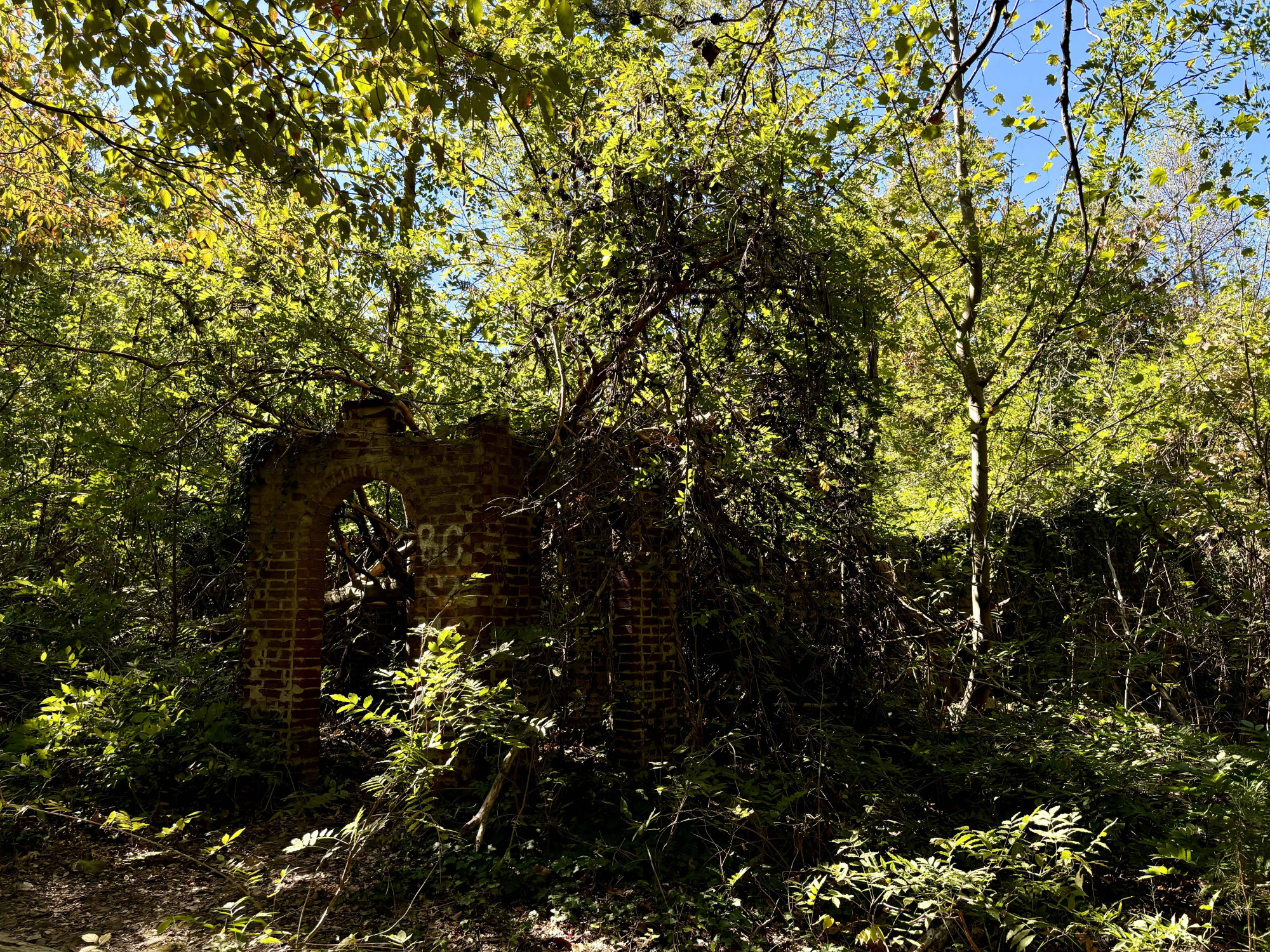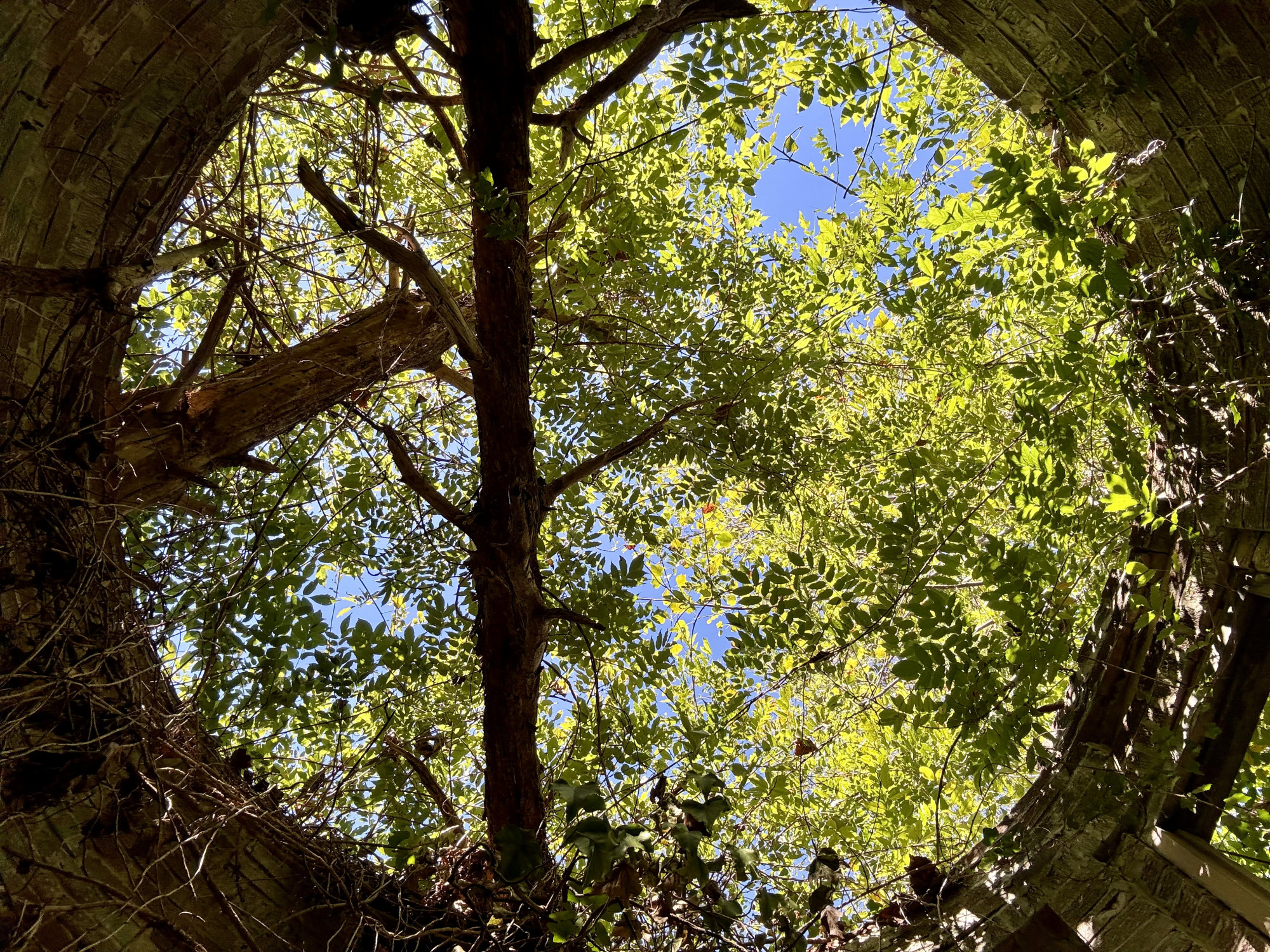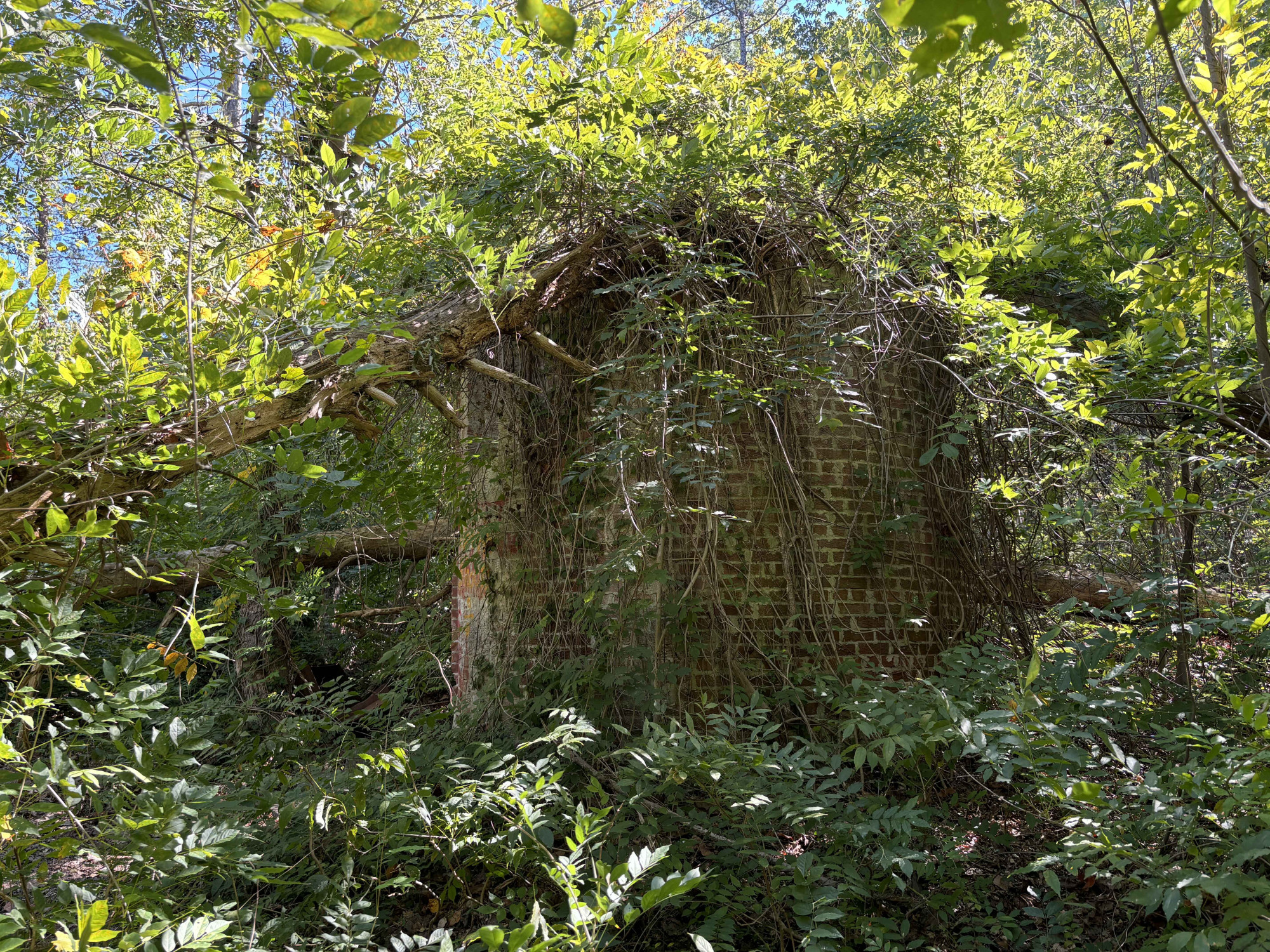The Corpsewood Manor Murders
Fearful Symmetry in the North Georgia Woods.
By Luke Gregson

Photo courtesy of author
In the winter of 1982, Dr. Charles Scudder and his partner Joseph Odom were slain in their medieval castle of a home. The murder and the ensuing manhunt of the killers have become the stuff of legend to the rural community of North Georgia, occult folklorists, hordes of true crime podcasters, and restless kids.
Of all the excursions I took to Corpsewood as a young man, none took place in the light of day. I spent hours in overloaded cars full of nervous college kids and climbing the switchbacks of the Chattahoochee in search of landmarks in the dark. A choir of voices recited details of their last trip without me—found Ouija boards, memory cards, candles, and Satanists hiding in the woods. A fire in the 1980s reduced the enigmatic “castle in the woods” to ruin, entombed by the Chattahoochee woodland surrounding it. It was on this ill-fated trip that we found ourselves lost, not for the first time.
Our group drove back into the town for directions. We solicited a twenty-something gas station clerk in a Slipknot t-shirt for directions up to the infamous murder site to no avail. Somehow, she had never even heard of Corpsewood. Defeated, we made our way out to the car outside, followed by an older man sparking the end of a cigarette. He exhaled a tight stream of smoke into our car as he spoke, giving us the directions to the murder site. The man alluded to his own time spent at Corpsewood with Scudder and Odom before their deaths. We thanked the stranger and as he walked away, he turned around, regarded us for a moment, and said, “Once you reach that road—you’ll feel it.”

Photo courtesy of author
The Corpsewood murders stand at the maw of the national “Satanic Panic” that gripped the country with stories of occultists roving the suburbs, midnight rituals, and human sacrifices.
A search of Corpsewood yields an 80s documentary from the Dove Broadcasting and WGGS-TV, complete with a proto-Twin Peaks synth soundtrack that somehow manages to portray Scudder and Odom as the villains of the story–conjuring demons to guard their home and scouting the area for sites to construct a Satanic temple. Speculation was and remains rampant about the two men.
Dr. Scudder held a PhD in Pharmacology from Loyola University, was an associate professor in the school’s Department of Pharmacology and Experimental Therapeutics, and was the associate director of the Institute for Mind, Drugs, and Behavior. While holding that position, Scudder conducted experiments involving hallucinogenic and psychoactive drugs. According to author Amy Petulla, who wrote the book The Corpsewood Manor Murders in North Georgia, the doctor was known to be somewhat of a renegade in the institution. He dyed his hair purple, kept a pet monkey, and penned a semi-regular column in a naturalist magazine. Petulla describes him as a gregarious man that kept his sexuality and dalliances with the occult secret from his colleagues. Scudder was a verified member of the LaVeyan sect of the Church of Satan. He adorned his home with Baphomets and pentangles and adhered to that branch’s orthodoxy of worldly pleasure over religion, but his devotion to any particular creed is difficult to pin down. Scudder was a curious student of the hidden world, the bookshelves he left behind tell us that much. Beneath the aesthetics of darkness and goat heads, Scudder was simply an atheist, a follower of the self.
There is far less written about Joseph “Joey” Odom, but the little we have puts his life in stark contrast to Scudder’s life of academia, science, and generational wealth. Odom dropped out of school after fifth grade. At some point, Odom became Scudder’s housekeeper, chef, and friend, before they eventually fell in love. The couple became disillusioned with the promises of their cosmopolitan life in Chicago. Urban decay had the pair seeking home beyond dense city blocks. A sanctuary, the pastoral, promised seclusion. A return to the primitive enticed the pair. After months of searching, they arrived in the town of Summerville in North Georgia. It was here, on forty acres of wildland, that they made home.
Corpsewood Manor was hand-constructed by Scudder and Odom with brick and furnished with renaissance furniture, stained glass murals of Baphomet, statues of the slender Mephistopheles, books on the occult, and human skulls from Scudder’s tenure at Loyola. The homestead had no utilities. The couple survived off the land and trips into the town down the ridge. The manor was rounded and contained no corners. A pink gargoyle perched atop the structure held vigil over the monolith below.
The now infamous chicken house was constructed a stone’s throw from the manor, a structure with coops on the first level and a pink-painted pleasure chamber above. The “Pink Room,” as it became known, housed mattresses, whips, pornography, and a guest book rumored to contain the signatures of over three hundred visitors, alongside their predilections. The book, amongst a trove of other items from the scene, vanished during the murder investigation. Local folklore contests that the names of several prominent men in the area were listed on its pages.
Cruising the town in their black Jeep, emblazoned with pentacles, caused a stir in Summerville, talk spread regarding the “queer devil worshippers” and their castle in the forest. By all accounts, Scudder and Odom were friendly and accommodating to curious folk and wandering deer hunters. On some occasions, locals were invited back with promises of potent homemade wine and joints.
Kenneth Avery Brock, seventeen at the time, was among the wanderers who found himself on the couple’s property after deer hunting nearby. Scudder invited the boy into their chicken house suite for muscadine wine and grass. In interviews with detectives, Brock alleged that at some point in the evening, Scudder performed oral sex on him, an act that he claimed he came back for several more times before the murders.
Brock’s accomplice Tony West casts a different shadow on the tale: A man pockmarked with violence and tragedy years before the Corpsewood slayings. Testimony paints West as wild, prone to bouts of cruelty, and in and out of detention centers for most of his life. It was in West’s trailer home where Brock spun the tale of the rich Satanists and their fiefdom in the forest. They incorrectly figured that the couple in the woods hoarded their cash and drugs in the walls of Corpsewood. The pair hastily devised a plan to torture and rob Scudder and Odom in the coming weeks.

Photo courtesy of author
On that night in December, Brock and West, with two teenagers Joey Wells and Theresa Hudgins in tow, visited the estate under the guise of a search for plum wine. In the jalopy they carried Brock’s mother’s .22 rifle, a paint thinner cocktail known as toot-a-loo, and the dream of coming down the mountain as rich men. Scudder was, as always, an amicable host offering the group flasks of wine.
As they imbibed on toot-a-loo and the spirits, Brock left the impromptu party under the pretense of fetching more paint thinner and returned with a rifle aimed squarely at the doctor. As they tied Scudder up, Brock made his way into the house, shooting Odom and their two dogs in the kitchen. As they led Scudder inside, he rushed toward his partner bleeding out on the kitchen floor, muttering to himself, “I asked for this.” West shot Scudder four times at close range. Before the cordite cleared the air, the two began looking in vain for tucked-away wealth. To their surprise, they heard Scudder choking on the floor. Brock proceeded to fire a fifth fatal round between Scudder’s eyes. Feet away from his body hung an eerily prescient portrait of Scudder, bound and gagged, five exit wounds upon his face twisted in agony. Odom was then executed as he attempted to drag his wounded body away from the scene. After a fruitless search and failed attempts to pick up Scudder’s gold-encrusted harp, the two made off the mountain in Scudder’s jeep with a dagger and handfuls of jewelry.
The two men’s bodies were found days later. By that time the killers had headed south, bound for Mexico. The pair dumped Scudder’s conspicuous Jeep at a Mississippi rest stop and murdered a dozing Navy lieutenant for his ride. Meanwhile, the teenagers that tagged along with West and Brock gave them up and the manhunt ensued. With little cash on hand and hard days of traveling, tension grew between Brock and West. They split after an altercation at a gentlemen’s club in Louisiana. Brock, suffocating under the weight of his crimes, gave himself up to authorities, West would follow suit days after. At their trial, both West and Brock maintained that the killing was committed under the influence after Scudder drugged the pair with his homemade LSD. There was little to no evidence to prove this. Tony West has since passed, but Avery Brock still sits in a Georgia penitentiary serving his life sentence.
I returned to Corpsewood seasons removed from my younger days. The scene is still every bit as gothic as Faulkner’s ghost, yet the landscape-choked ruins seem at peace with their complex history. The skeletons of this place were abandoned, but remain. Their murder and life in self-imposed exile render the story fodder for true crime podcasters and YouTube thrillseekers, though, reduced to its basest parts, it’s a story fitting of the South: old religion, seclusion, and violence. It’s a confluence that keeps the story alive and folks visiting a dead man’s home.
Storytellers imbue Corpsewood with a demonic energy, that Scudder and Odom in their deaths left behind a darkness, but the only thing that remains here is an expired crime scene.
We grasp for an existential narrative in the face of commonplace greed. Evangelical documentarians tell the story of two perverse prophets on the mountain who got what was coming to them. College freshmen relish in telling the story of murdered satanists as a campfire story in dorm rooms. True crime podcasters tell the story of sadistic violence as an act of voyeurism. Occultists use the land as an altar, conjuring ghosts out of tragedy.
Wickedness does haunt the land—the sins of two men who murdered their neighbors for the money they did not have. Outsiders existing on the margins of a strange land that did not fully accept them or their unusual ways.
In the years since Scudder and Odom’s murder, visitors made off with relics from the homestead—detritus, signs, bricks, and furniture, yet an audio recording remains, Scudder on the morning of his death reciting William Blake over the sparse plucking of his harp,
“Tyger Tyger, burning bright,
In the forests of the night;
What immortal hand or eye,
Could frame thy fearful symmetry?
In what distant deeps or skies.
Burnt the fire of thine eyes?
On what wings dare he aspire?
What the hand, dare seize the fire?”




